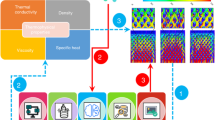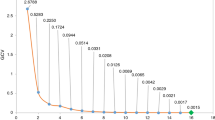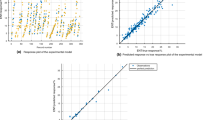Abstract
Machine learning (ML) provides an array of methodologies for understanding many challenging obstacles in multiple domains, mostly the discipline of heat transfer and thermal systems. In nanofluid investigations about thermophysical attribute prediction and thermo-hydrodynamic performance testing, machine learning methods would be particularly helpful. The goal of the current review is to examine the advantages and uses of various machine learning algorithms applied in nanofluid-based vapour compression refrigeration systems and to highlight recent advancements in this field. The rapid development of nanofluids is being driven by a record amount of data from experiments, field observations, and extensive simulations at multiple space and time scales. There are many ways to collect data-related information from machine learning that can be used to comprehend the use of nanofluids. The importance of ML in assessing the thermophysical characteristics of nanofluid is in-depth highlighted. The forecasting of thermophysical characteristics and heat transfer rate using data-driven machine learning techniques will be helpful in finding the most important aspects in nanofluid research.
Access this chapter
Tax calculation will be finalised at checkout
Purchases are for personal use only
Similar content being viewed by others
References
Mahesh B (2020) Machine learning algorithms—a review. Int J Sci Res (IJSR) [Internet] 9:381–386
Geron A (2017) Hands-on machine learning with Scikit-Learn, keras, and TensorFlow: concepts, tools, and techniques to build intelligent systems
Van Der Walt, Stefan S, Colbert C, Varoquaux G (2011) The NumPy array: a structure for efficient numerical computation. Comput Sci Eng 13(2):22–30
Pedregosa F et al (2011) Scikit-learn: machine learning in Python. J Mach Learn Res 12:2825–2830
Gill J, Singh J (2017) Performance analysis of vapor compression refrigeration system using an adaptive neuro-fuzzy inference system. Int J Refrig 82:436–446
Cao X et al (2016) Refrigerant flow through electronic expansion valve: experiment and neural network modeling. Appl Therm Eng 92:210–218
Hosoz M, Ertunc HM (2006) Modelling of a cascade refrigeration system using artificial neural network. Int J Energy Res 30(14):1200–1215
Rashidi MM, Aghagoli A, Raoofi R (2017) Thermodynamic analysis of the ejector refrigeration cycle using the artificial neural network. Energy 129:201–215
Gill J et al (2019) Energy analysis of a domestic refrigerator system with ANN using LPG/TiO2–lubricant as replacement for R134a. J Therm Anal Calorim 135:475–488
Ledesma S et al (2017) Neural lab a simulator for artificial neural networks. In: 2017 computing conference. IEEE
Li H et al (2022) Cutting fluid corrosion inhibitors from inorganic to organic: progress and applications. Korean J Chem Eng 39(5):1107–1134
Pare A, Ghosh SK (2021) A unique thermal conductivity model (ANN) for nanofluid based on experimental study. Powder Technol 377:429–438
Esfe MH et al (2015) Modelling and estimation of thermal conductivity of MgO–water/EG (60:40) by artificial neural network and correlation. Int Commun Heat Mass Transfer 68:98–103
Ma M et al (2020) Synergistic mechanism of thermal conductivity enhancement and economic analysis of hybrid nanofluids. Powder Technol 373:702–715
Goudarzi S et al (2020) Nanoparticles migration due to thermophoresis and Brownian motion and its impact on Ag-MgO/water hybrid nanofluid natural convection. Powder Technol 375:493–503
Esfe MH, Bahiraei M, Mir A (2020) Application of conventional and hybrid nanofluids in different machining processes: a critical review. Adv Colloid Interface Sci 282:102199
Asadi A, Alarifi IM, Foong LK (2020) An experimental study on characterization, stability and dynamic viscosity of CuO-TiO2/water hybrid nanofluid. J Mol Liquids 307:112987
Li X, Wang H, Luo B (2021) The thermophysical properties and enhanced heat transfer performance of SiC-MWCNTs hybrid nanofluids for car radiator system. Colloids Surf A 612:125968
Ma T et al (2021) Recent trends on nanofluid heat transfer research applied to renewable energy. Renew Sustain Energy Rev 138:110494
Ghazvini M et al (2020) Experimental evaluation and artificial neural network modelling of thermal conductivity of water based nanofluid containing magnetic copper nanoparticles. Phys A: Stat Mech Appl 551:124127
Tahmooressi H et al (2020) Numerical simulation of aggregation effect on nanofluids thermal conductivity using the lattice Boltzmann method. Int Commun Heat Mass Transfer 110:104408
Kanti PK et al (2022) Experimental investigation on thermal conductivity of fly ash nanofluid and fly ash-Cu hybrid nanofluid: prediction and optimization via ANN and MGGP model. Part Sci Technol 40(2):182–195
Kumar V et al (2021) Efficacy evaluation of oxide-MWCNT water hybrid nanofluids: an experimental and artificial neural network approach. Colloids Surf A: Physicochem Eng Asp 620:126562
Meijuan C (2021) Application of ANN technique to predict the thermal conductivity of nanofluids: a review. J Therm Anal Calorim 145(4):2021–2032
Jamei M et al (2021) On the thermal conductivity assessment of oil-based hybrid nanofluids using extended Kalman filter integrated with feed-forward neural network. Int J Heat Mass Transfer 172:121159
Pourrajab R et al (2021) A meticulous intelligent approach to predict thermal conductivity ratio of hybrid nanofluids for heat transfer applications. J Therm Anal Calorim 146(2):611–628
Motlagh SY et al (2019) Presentation of new thermal conductivity expression for Al2O3–water and CuO CuO–water nanofluids using gene expression programming (GEP). J Therm Anal Calorim 135:195–206
Jamei M et al (2021) On the specific heat capacity estimation of metal oxide-based nanofluid for energy perspective—a comprehensive assessment of data analysis techniques. Int Commun Heat Mass Transfer 123:105217
Carrillo-Berdugo I et al (2020) Understanding the specific heat enhancement in metal-containing nanofluids for thermal energy storage: experimental and ab initio evidence for a strong interfacial layering effect. ACS Appl Energy Mater 3(9):9246–9256
Cherecheş EI et al (2020) Viscosity and isobaric specific heat capacity of alumina nanoparticle enhanced ionic liquids: an experimental approach. J Mol Liq 317:114020
Murshed SMS, Estelle P (2017) A state-of-the-art review on viscosity of nanofluids. Renew and Sustain Energy Rev 76:1134–1152
Ramezanizedeh M et al (2019) A review on the utilized approaches for modelling the dynamic viscosity of nanofluids. Renew Sustain Energy Rev 114:109345
Gholami E, Vaferi B, Ariana MA (2018) Prediction of viscosity of several alumina-based nanofluids using various artificial intelligence paradigms—comparison with experimental data and empirical correlations. Powder Technol 323:495–506
Gholizadeh M et al (2020) Prediction of nanofluids viscosity using random forest (RF) approach. Chemometr Intell Lab Syst 201:104010
Adun H et al (2022) Estimation of thermophysical property of hybrid nanofluids for solar thermal applications: implementation of novel optimizable Gaussian process regression (O-GPR) approach for viscosity prediction. Neural Comput Appl 34(13):11233–11254
Adun H et al (2020) A neural network-based predictive model for the thermal conductivity of hybrid nanofluids. Int Commun Heat Mass Transfer 119:104930
Sharma P et al (2022) Comparative evaluation of AI‐based intelligent GEP and ANFIS models in prediction of thermophysical properties of Fe3O4‐coated MWCNT hybrid nanofluids for potential application in energy systems. Int J Energy Res 46(13):19242–19257
Author information
Authors and Affiliations
Corresponding author
Editor information
Editors and Affiliations
Rights and permissions
Copyright information
© 2024 The Author(s), under exclusive license to Springer Nature Singapore Pte Ltd.
About this paper
Cite this paper
Patel, H., Kumar Singh, D., Prakash Verma, O., Kadian, S. (2024). Machine Learning Approach for Thermal Characteristics and Improvement of Heat Transfer of Nanofluids—A Review. In: Verma, O.P., Wang, L., Kumar, R., Yadav, A. (eds) Machine Intelligence for Research and Innovations. MAiTRI 2023. Lecture Notes in Networks and Systems, vol 831. Springer, Singapore. https://doi.org/10.1007/978-981-99-8135-9_20
Download citation
DOI: https://doi.org/10.1007/978-981-99-8135-9_20
Published:
Publisher Name: Springer, Singapore
Print ISBN: 978-981-99-8134-2
Online ISBN: 978-981-99-8135-9
eBook Packages: Intelligent Technologies and RoboticsIntelligent Technologies and Robotics (R0)




